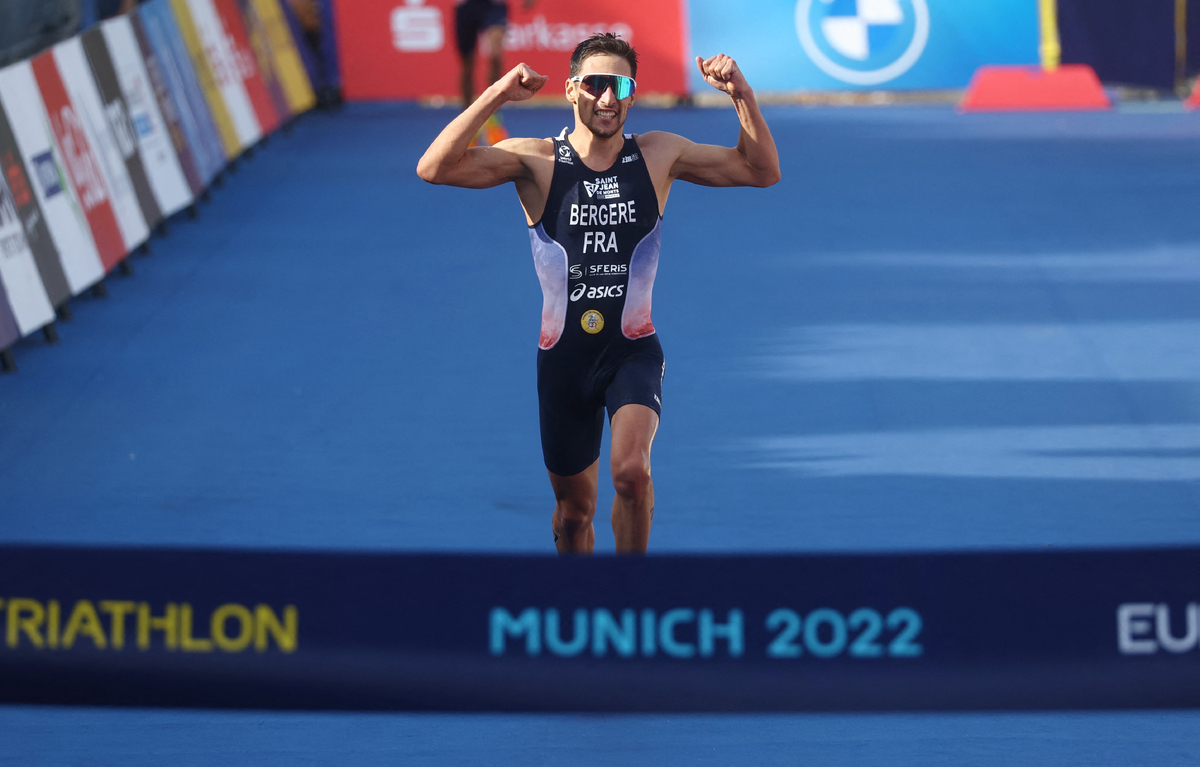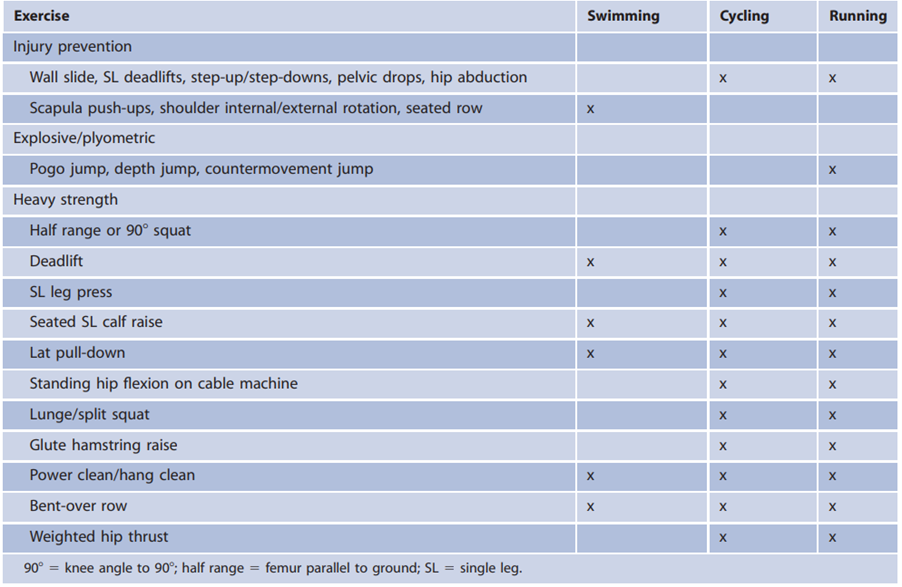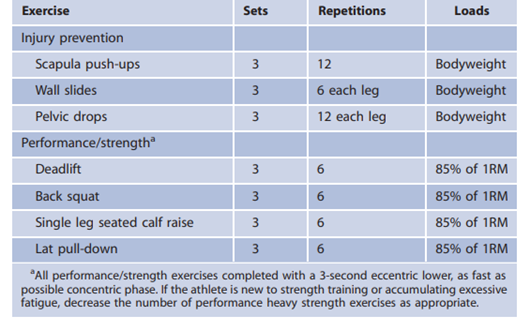You are viewing 1 of your 1 free articles
Time crunch: strength training in triathletes
Combining three sports into one event creates a unique spectacle for fitness enthusiasts and fans. Triathlon training is time-consuming, and athletes prioritize endurance training to improve performance. However, what if strength training could improve all three disciplines and reduce injury risk? Andrew Berry uncovers the role of strength training in triathlons and provides a brief insight into its implementation into crammed training programs.

Olympiapark Triathlon Course, Munich, Germany - France’s Leo Bergere in action before he crosses the finish line to win the Men’s Triathlon Elite Final REUTERS/Kai Pfaffenbach
Triathlon has been an Olympic sport since 2000 and has been growing rapidly among recreational and elite athletes(1). Triathlons require athletes to dedicate time to training each discipline: swimming, cycling, and running. Training for three sports, many lack time to fit in strength training or feel extra endurance training would be more beneficial. Furthermore, there is very limited research on triathletes. Still, practitioners and athletes can analyze the research on the effects of strength training and injury reduction in the three specific sports.
Strength training comprises explosive and heavy-weight training. Strength training improves movement economy, anaerobic capacity, and maximal speed. It also delays fatigue and, most importantly, prevents injury in endurance athletes(2). However, despite these findings, only 54.6% of triathletes included some form of strength training in their normal training regime. They report barriers such as time restraints and a lack of knowledge on exercise selection, progressions, and proper technique(4). Triathletes and coaches often complete “strength-endurance” workouts such as swimming with paddles, cycling in a big gear (low-cadence), or hill repeats to build strength. However, this does not conform with the definition of strength training and does not provide the same benefits as heavy weightlifting(4). This practice is concerning as strength training is the most effective form of injury prevention and results in performance benefits for the athletes.
The prevalence of overuse injuries in triathletes is 56%, and substantial overuse injuries of 20%. The most common site of injury is the knee (25%), followed by the lower limb and lower back (23%)(1). Another study found that the most common site of injury is the knee (44%), calf (20%), hamstring (20%), and lower back (20%), with most injuries sustained while running (60%)(1). Due to the high demands of triathlon, science and research play an integral role in how athletes plan their training demands to maximize performance gains while minimizing chances of injury.
Researchers at the Institute of Sports Medicine Copenhagen in Denmark conducted a systematic review with 26 610 participants to determine if exercises can reduce sports injuries. The researchers found that sports injuries were reduced to less than one-third and overuse injuries more than halved. Stretching was found not to affect injury prevention(5). Furthermore, strength training to prevent ACL injuries in runners should start within the off-season, run for at least six weeks, and then continue during the competitive season at a less frequent rate of one to two times a week(3). There is clear evidence of the beneficial impact of strength training on performance and injury prevention. As a lack of knowledge on exercise selection remains a barrier to entry, triathletes and coaches can refer to evidence-based guidelines to ensure an optimal prescription (see table 1).

Strength training is not a magical solution for all triathletes’ injuries, and practitioners must be cautious when prescribing programs to get the best results. As triathletes have high-load training programs, adding strength exercises may increase their risk when injuries are load-based. Furthermore, if athletes have limited experience with strength training, improper execution may cause injury and hinder their endurance training. Therefore, the focus of triathlete training needs to remain on the endurance components, with strength training as an adjunctive method to improve performance and reduce injury. Furthermore, inappropriate prescription may lead to reductions in performance(6). One possible solution is the utilization of block periodization, which changes the volume of strength training in accordance with race season periods. Strength training could be a powerful tool for athletes competing in triathlons or any endurance event with the right guidance and coaching.
Strength training is significantly beneficial for performance for both cycling and running. In addition, endurance sports require athletes to train consistently, and the injury-prevention benefits of strength training may allow athletes to remain fit and healthy and train optimally(6). Therefore, when prescribed appropriately, strength training is more beneficial when conducted in an organized manner (i.e., block periodization).
Related Files

Conclusion
Despite the reported barriers to completing regular strength training, triathletes should seek to include it in their endurance programs. Practitioners should educate athletes on the injury prevention benefits and reconceptualize the importance of strength training as a vehicle to allow athletes to train better rather than as a time-consuming hindrance. Professional supervision is needed for athletes with limited experience to ensure the correct training volumes, frequencies, and intensities. As strength training makes its way into the triathlon industry, sports medicine professionals will be at the forefront of ensuring successful compliance by creating a culture that facilitates strength training as a norm rather than a dogma. There is ample evidence to suggest that strength training effectively prevents athletes from getting injured and future studies should aim to identify the optimal prescription for triathletes.
References:
- Br J Sports Med, 2013, 47(13), pp.857–861.
- Scand J Med Sci Sports, 2013, 24(4), pp.603–612.
- Phys Ther Sport, 2014, 15(3), pp.200–210.
- Strength Cond J, 2021.
- Br J Sports Med, 2014, 48(11), pp.871–877.
- Acta Kinesiologica 14, 2020, pp.16–21.
Newsletter Sign Up
Subscriber Testimonials
Dr. Alexandra Fandetti-Robin, Back & Body Chiropractic
Elspeth Cowell MSCh DpodM SRCh HCPC reg
William Hunter, Nuffield Health
Newsletter Sign Up
Coaches Testimonials
Dr. Alexandra Fandetti-Robin, Back & Body Chiropractic
Elspeth Cowell MSCh DpodM SRCh HCPC reg
William Hunter, Nuffield Health
Be at the leading edge of sports injury management
Our international team of qualified experts (see above) spend hours poring over scores of technical journals and medical papers that even the most interested professionals don't have time to read.
For 17 years, we've helped hard-working physiotherapists and sports professionals like you, overwhelmed by the vast amount of new research, bring science to their treatment. Sports Injury Bulletin is the ideal resource for practitioners too busy to cull through all the monthly journals to find meaningful and applicable studies.
*includes 3 coaching manuals
Get Inspired
All the latest techniques and approaches
Sports Injury Bulletin brings together a worldwide panel of experts – including physiotherapists, doctors, researchers and sports scientists. Together we deliver everything you need to help your clients avoid – or recover as quickly as possible from – injuries.
We strip away the scientific jargon and deliver you easy-to-follow training exercises, nutrition tips, psychological strategies and recovery programmes and exercises in plain English.










